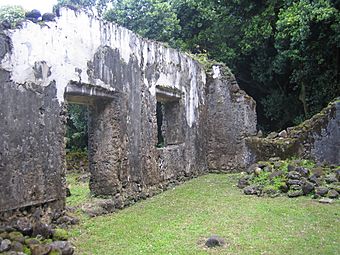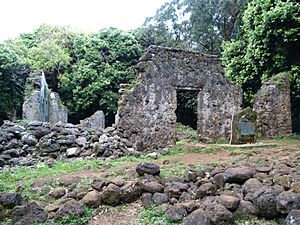Kaniakapupu facts for kids
Quick facts for kids |
|
|
Kaniakapūpū
|
|

Ruins of Kaniakapūpū
|
|
| Lua error in Module:Location_map at line 420: attempt to index field 'wikibase' (a nil value). | |
| Nearest city | Nuʻuanu, Hawaii |
|---|---|
| Built | 1845 |
| NRHP reference No. | 86002805 |
| Added to NRHP | October 15, 1986 |
Kaniakapūpū is the remains of a special summer palace once used by King Kamehameha III and Queen Kalama. It is located on the island of Oahu in Hawaii. The name Kaniakapūpū means "the singing of the land shells." Before, it was known as Luakaha, which means "place of relaxation."
The palace was built in the 1840s in the cool, green uplands of the Nuʻuanu Valley. It became the king and queen's summer home after the capital of the Kingdom of Hawaii moved from Lahaina to Honolulu in 1845. Kaniakapūpū became famous for a huge luau (a Hawaiian feast) held there in 1847. About ten thousand guests attended this celebration for Hawaiian Sovereignty Restoration Day. By 1874, the palace was already in ruins. Today, the site is officially closed to the public to protect it.
Contents
Understanding the Name Kaniakapūpū
Kaniakapūpū is the name most often used for this historic site today. It means "the singing of the land shells" in the Hawaiian language. This name comes from the kāhuli, which are Oʻahu tree snails. These snails were once very common in the area. Hawaiian stories say they could sing beautiful songs at night.
Some experts believe the name Kaniakapūpū might be a newer name, possibly from the early 1900s. Old stories, called moʻolelo (oral accounts), connect this name to a stone structure near the palace. This structure was thought to be a heiau, which is a Hawaiian temple. This specific heiau was believed to be for Lono, the Hawaiian god of farming and healing. Some traditions say the king might have built his palace on or near a heiau because of the mana (spiritual power) of the place.
However, other historical records suggest that the actual Kaniakapūpū heiau was in a different area of Oahu. These records do not mention a heiau directly at the palace site. The name Luakaha was used for the property during the king's time. Luakaha was a traditional land division in the Nuʻuanu Valley. The palace itself was often called "the king's house" or "retreat in Luakaha."
Luakaha was also an important place during King Kamehameha I's invasion of Oahu in 1795. Stories say Kamehameha I rested his troops near this site. This invasion ended with the important Battle of Nuʻuanu, where many Oahu warriors were pushed off the Nuʻuanu Pali.
History of the Royal Retreat

In the early 1800s, Honolulu was a dry, dusty place. Many people, including American missionaries, traders, and Hawaiian royals, built homes a few miles away in the cooler, forested Nuʻuanu Valley. They wanted to escape the summer heat. Kaniakapūpū was about five miles from the city. People could reach it by horse and carriage.
The land where Kaniakapūpū stands became part of the Crown Lands in 1848. This happened during the Great Māhele, a time when land ownership in Hawaii was changed. King Kamehameha III also gave nearby land to his friend Keoni Ana. Keoni Ana built Hānaiakamalama close by to be near the king.
Kaniakapūpū was finished in 1845. It became a place where the king entertained important visitors, chiefs, and common people. On Hawaiian Sovereignty Restoration Day in 1847, King Kamehameha III and Queen Kalama hosted a huge luau at the palace. This day celebrated the fourth anniversary of Hawaii getting its independence back. This happened after a five-month British occupation in 1843, known as the Paulet Affair. About ten thousand people came to this luau. Children from the Royal School, including all future Hawaiian monarchs, often visited the palace with their teachers.
By 1874, maps of the area already called the site "Old Ruins." This means it was falling apart. We don't know exactly why the palace was abandoned.
Protecting Kaniakapūpū Today
The ruins of Kaniakapūpū were found again in the 1950s. The Territorial Commission on Historic Sites worked to clear the area and make the ruins stable. However, over the next 30 years, the site got worse because it wasn't maintained. In 1998, a fund was started to pay for preservation work. This work was finished two years later.
Today, the State Historic Preservation Division of Hawaii's Department of Land and Natural Resources (DLNR) manages the site. They get help from groups like the Historic Hawaii Foundation. Kaniakapūpū was added to the National Register of Historic Places on October 15, 1966. This list helps protect important historical sites.
Kaniakapūpū is located at the end of a hidden trail off the Pali Highway. The area around the ruins is covered by a forest of invasive bamboo. This bamboo can damage the ruins with its roots. So, workers need to clear it regularly. The trail and the ruins are in a protected watershed area. This means they are officially off-limits to the public. State officials don't always watch the site, but people caught trespassing can get a ticket.
Damage to the Ruins
In 2016, people damaged Kaniakapūpū by scratching crosses into the old stone walls. Before this, tourists had carved their initials or climbed on the walls for photos. These actions further harmed the ancient structure. State officials and volunteers said these acts showed "utter disrespect" for the site's cultural importance.
Social media was blamed for bringing unwanted visitors to the site. Many posts did not mention that the area is closed to the public. After the damage, the state of Hawaii asked social media sites and travel blogs to remove directions to Kaniakapūpū. They also encouraged people who knew the way to visit with respect.
Historical Plaque
A special plaque was put up at Kaniakapūpū by the Commission on Historical Sites. It tells visitors about the palace's history:
- KANIAKAPUPU
- SUMMER PALACE OF KING KAMEHAMEHA III AND HIS QUEEN KALAMA
- COMPLETED IN 1845 IT WAS THE SCENE OF ENTERTAINMENT OF FOREIGN CELEBRITIES AND THE FEASTING OF CHIEFS AND COMMONERS. THE GREATEST OF THESE OCCASIONS WAS A LUAU ATTENDED BY AN ESTIMATED TEN THOUSAND PEOPLE CELEBRATING HAWAIIAN RESTORATION DAY IN 1847.
—COMMISSION ON HISTORICAL SITES
See also
 In Spanish: Kaniakapupu para niños
In Spanish: Kaniakapupu para niños




